Deaths and test results
No further deaths at York Hospital Trust announced today
63 (SIXTY THREE) additional positive test results announced today. Brings cumulative total to 3652
Continuing downward trend in number of cases. Now below 80 cases per per day per week. Rate per 100k population was down to 257.82 on Tuesday from a peak of 309.58 the previous week.
Half the 24 neighbourhoods in York are now showing week on week reductions in new case levels. Only 3 (Heslington, Rawcliffe/Clifton South and Clifton Without/Skelton) have shown above national average rates of infections during the whole of the last 10 days.
The Woodthorpe/Acomb Park area is showing an increase in case numbers.
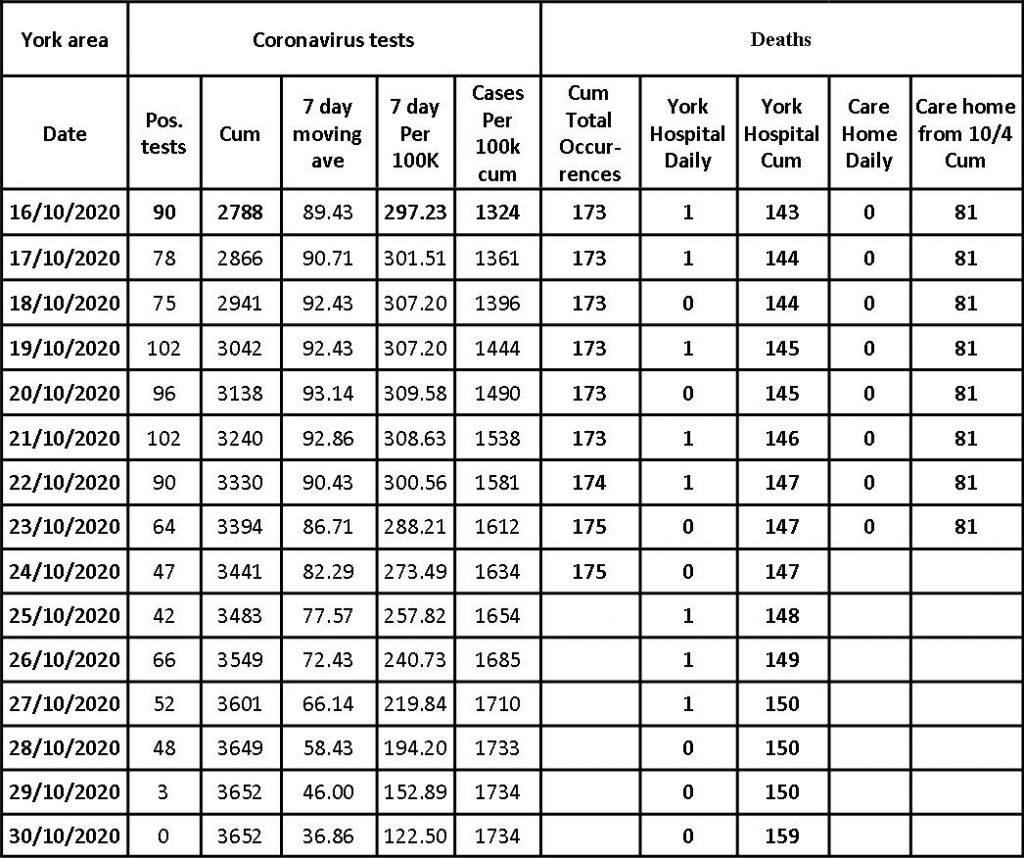
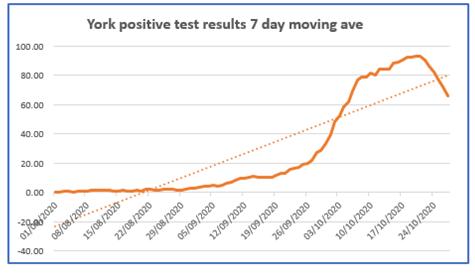
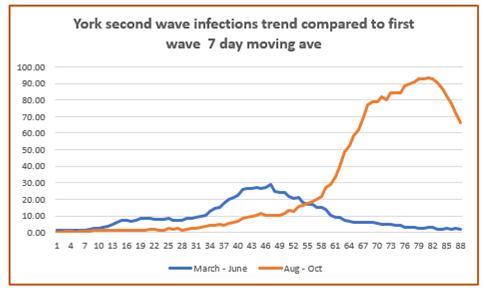
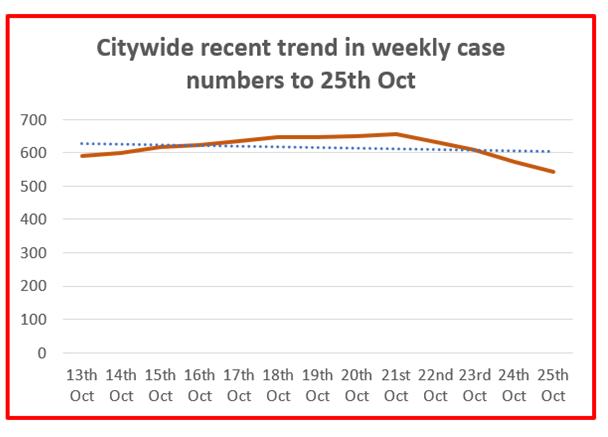
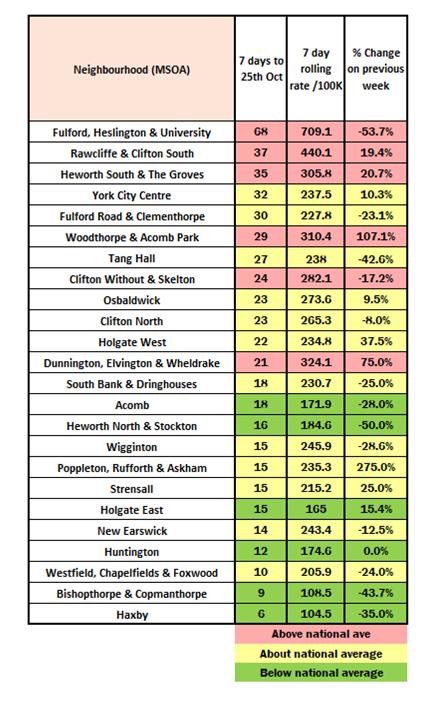
Council commentary updated
The York Council has updated its weekly commentary on the pandemic. It can be found on the open data web site. It is reproduced below
People with Covid Symptoms
• NHS Pathways/111 triages – as at 26.10.20 there had been 273 total covid triages in the CYC area in the last 7 days. The peak number of triages was 653 in the 7 day period to 20.9.20. • As at 28.10.20, the Covid Symptom App estimates 860.1 per 100,000 in York with symptomatic covid (responses from a sample of 5,095 people). The peak rate was 1,051.7 on 22.10.20
Diagnosed cases (Pillar 1&2 combined)
• As at 29.10.20 York has had 3,589 cases since the start of the pandemic, a rate of 1,704 per 100,000 of population. The rate in York is above the national average (1,454.6) but below the regional average (2,222.4).
• The PHE ‘Exceedance’ rating compares the no. of new cases over a 14 day period with the previous 6 weeks and provides a RAG rating to indicate if the previously observed trend in the no. of new cases is worsening. The latest rating for York (26.10.20) is Green.
• The provisional rate of new Covid cases per 100,000 of population for the period 21.10.20 to 27.10.20 in York is 213.66 (Using data published on Gov.uk on 29.10.20).
• The latest official “validated” rate of new Covid cases per 100,000 of population for the period 18.10.20 to 24.10.20 was 272.5. The national and regional averages at this date were 225.9 and 390.1 respectively (Using data published on Gov.uk on 29.10.20).
• As at 26.10.20, the latest 7 day positivity rate in York (Pillar 2 only) was 13.1%. The national and regional averages are 10.2% and 14.8% respectively. The number of Pillar 2 tests being carried out in York is increasing.
• As at 29.10.20 York University reported 117 individuals within the University community who were currently self-isolating because they have had a positive COVID-19 test.
• As at 28.10.20 York St. John reported 34 individuals within the University community who were currently self-isolating because they have had a positive COVID-19 test.
Contact Tracing
• Since 28.5.20 a total of 3,020 laboratory confirmed CYC Covid cases have been uploaded into the NHS Test and Trace system and 2,523 of the cases have been engaged. 9,442 ‘contacts’ have been identified and 5,573 of these have been traced.
Deaths
The two sources about deaths from Covid-19 at LA level are ONS data and local registrar data. They are derived from the same source (civil registration data). ONS data is more comprehensive as it includes deaths of York residents which have occurred and been registered outside York. Local registrar data is useful as it provides a breakdown by age and gender. The most recently available data is summarised below:
• ONS weekly data: For deaths occurring up to 16th October 2020 and registered up to 24th October 2020, 175 deaths were recorded as having occurred for CYC residents (84 in hospital, 78 in care homes, 9 at home and 4 in a hospice). The number of deaths per 100,000 of population in York is 83.09 which is lower than the national average of 91.44. The most recent deaths reported for York residents occurred in week 42 (10 to 16 October).
• ‘Excess’ deaths (ONS. In week 42 (10 Oct to 16 Oct), 37 deaths occurred for York residents, which is 8 more than the average weekly number for 2014-18. Over the last 21 weeks the total number of deaths in York has been 44 fewer than the average for the equivalent weeks in 2014-18.
• Local Registrar data: In the weekly data received on 26.10.20 (for deaths occurring up to 21.10.20), a cumulative total of 167 deaths of CYC residents where COVID-19 was mentioned (confirmed or suspected) on the death certificate, have been registered. The average age of the people who died was 82.5, with an age range of 53-104. The age profile of those dying in York is slightly older than the national average. 87 of the 167 were male (52.1%), slightly less than the national average (55.2%). 72 people (43.1%) died in nursing /care homes (the national average is 28.98%). In addition 13 people (7.78%) who normally resided in nursing/care homes in the CYC area, died in hospital.
Data on deaths occurring in hospital are shown below. Deaths are initially reported for York NHS Foundation Trust which includes Scarborough Hospital and the further breakdown by site can be delayed. From local registrar data, 55.2% of COVID-19 deaths occurring at York Hospital have been CYC residents. (NB NHS Trusts record deaths following a positive covid-19 test (within 28 days) whereas ONS record deaths where covid-19 in mentioned on the death certificate so the totals are not the same).
• Deaths at York Hospital: As at 29.10.20, 144 deaths (awaiting confirmation of breakdown by hospital site for recent deaths) where the person had tested positive for COVID-19 and were being cared for at York Hospital have been reported. 230 deaths have been reported by the wider York NHS Trust.
Local tracing success
York’s local contact tracing programme has been running for one week now and data is already showing it has had an immediate impact.
Since launching the service last week, York’s contact tracers have got in touch with 83.7% of residents in the past six days who the national system were unable to reach. More than 100 residents have now been successfully contacted, with low numbers of people uncontactable. On Wednesday 28 October, the local service reached 100% of people that the national system were unable to reach.
The service is currently running Monday to Friday and will soon be running as a seven days a week service, with residents being contacted using a local (01904) phone number.
Text messages will also be sent to people with mobile phones telling them to expect a call. If this is still unsuccessful, then a home visit will be made, and if no-one is at home, a letter with details of how to contact the team will be delivered to those advised to isolate, following Covid-19 guidelines.
Councillor Keith Aspden, Leader of City of York Council and Chair of the York Outbreak Management Advisory Board said:
Thank you to our public health team who are working alongside the national test and trace system to reach more people who have tested positive quickly, which is vital in our efforts to slow the spread of the virus.
“Our local programme places a real priority on the wellbeing of our residents. We will check if they are ok and offer them support should they need it, whether that be getting food and medicine, or simply talking to someone while they self-isolate. With the national system continuing to face difficulties, we will soon be expanding our local programme to run a 7 day service, in order to reach more residents.”
“We are particularly grateful to all those who are self-isolating or have self-isolated. We know how hard it is, but it is an incredibly important thing to do to keep our friends, family and community safe.”
Fiona Phillips, Assistant Director for Public Health said:
We have really appreciated the support of the public following the launch of this service when we have been in contact with them.
“We would ask people to continue to engage with the service as it really does make a difference in slowing the spread of the virus as the vast majority have so far, which we are very grateful for.
“We know that testing positive for Coronavirus can be a worrying time and we are here to help. Our contact tracers will check you are ok and offer support. After our call, our helpline is there to help those who need it.
“Rapid contact tracing and self-isolation are a key way of stopping the spread of Coronavirus. This is once again a demonstration of a true citywide effort to keep the people we love safe and the places we love open.

